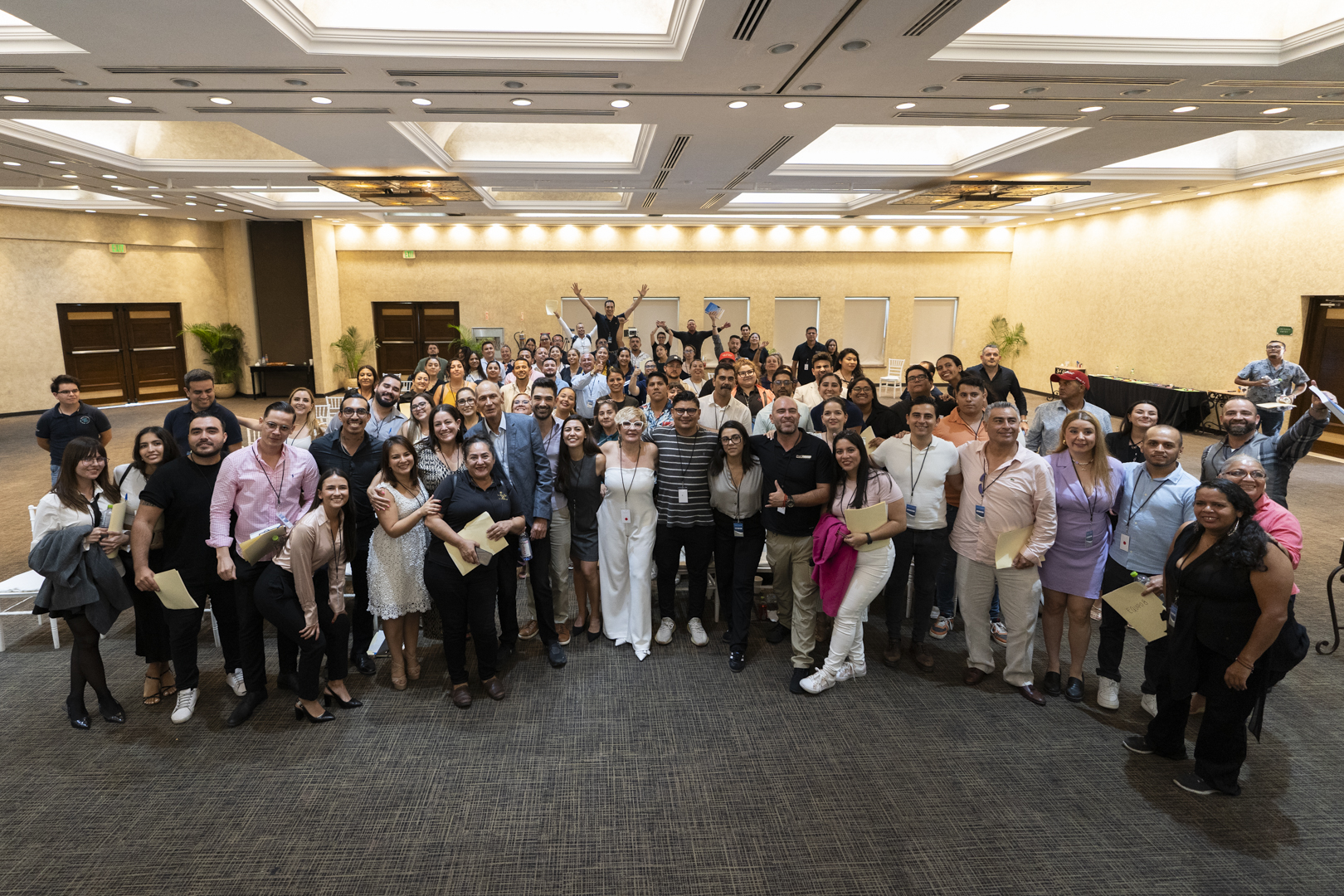EXPLORING THE ESSENCE OF LEADERSHIP: UNVEILING THE SECRET OF EFFECTIVE STRATEGIES
Robert Kistner And Cami Nelson
julio 10, 2024

EXPLORING THE ESSENCE OF LEADERSHIP: UNVEILING THE SECRET OF EFFECTIVE STRATEGIES
In today’s fast-paced world, the passion of leading cannot be denied. But have you ever stopped to think about what it really means to be a leader? Bob Kistner is an accomplished business leadership visionary with extensive experience and a track record of success in the vibrant tourism industry.
Bob’s journey is one of relentless pursuit and unwavering dedication to building thriving businesses from the ground up. With a knack for building high-performing teams and developing bold strategies, he has taken companies to unprecedented heights, achieving impressive eight-figure profits along the way.
But Bob’s story is more than just a story of financial success. It is a testament to the power of vision, resilience and an unwavering commitment to excellence. Throughout his illustrious career, Bob has not only navigated the rigors of the business environment, but has also developed a deep understanding of what it means to lead with integrity, compassion and vision.
Want to know more about Bob’s unique journey? Are you interested in knowing the secrets behind his phenomenal success? Read on as we delve into Bob’s valuable lessons, his hard-won wisdom, and his life-changing experiences.
¿WHAT’S LEADERSHIP AND WHAT IT INVOLVES BEING A LEADER?
We constantly hear the word leadership, but we do not know more about its meaning.
Before delving into this guide of effective strategies we must start from the question: What is leadership and what is it to be a leader?
Leadership is a multidimensional concept encompassing many skills, attributes, and behaviors. At its core, leadership refers to the ability to influence others to achieve a common goal. But being a leader goes beyond just holding a position of authority or a proper title. Being a leader means having a clear and inspiring vision that inspires and motivates others. That includes the ability to communicate a vision and articulate a strategy effectively. Leaders can build trust with those around them, fostering a shared purpose and commitment to the success of the team or organization.
Additionally, leaders model their values and principles. They operate with honesty, integrity, and ethics in all dealings. They are role models who set the tone for expected behaviors within the group.
Being a leader also includes developing and empowering others. Leaders not only seek their own success, they also seek to empower those around them. They encourage an environment of learning and development, providing support and guidance as team members develop their skills and take on more responsibility.
Bold Leadership Unveiled: A Comprehensive Guide from «Make It Happen Leadership”
In today’s business landscape, with constant evolution and dynamism, effective leadership is an essential part of success, serving as a driving force behind organizational growth and resilience. Previously, leadership was limited to simply managing teams and processes; Today, it encompasses a dynamic mix of vision, adaptability and emotional intelligence.
Leaders in the digital age face unprecedented challenges and opportunities. The rapid pace of technological advancement can change the way we work, collaborate, and innovate, so leaders must adapt to keep pace with this changing environment. Researching leadership in the digital age requires understanding how technology affects the way teams lead and how these tools can be used to drive productivity, collaboration, and innovation.
The key to leadership in the digital age is the ability of leaders to embrace and optimize new technologies. Not only will you be exposed to the latest technological developments, but you will understand how these tools can be better integrated into business processes and organizational culture. Digital leaders must be proactive in developing new tools and platforms that can improve the efficiency and productivity of their teams.
Business leadership changes traditional management roles, transforming into a multifaceted practice aimed at inspiring, guiding and empowering people towards collective success. At its core, it represents a blend of skills, attributes and qualities that enable leaders to navigate the complexities of the modern business world with skill and effectiveness.
An important point of effective leadership comes in the ability to inspire and motivate others. Leaders with a clear vision and compelling purpose can unite their teams around shared goals, fostering a sense of unity and purpose. By articulating a bold vision for the future, these leaders encourage passion and enthusiasm, propelling their organizations to greater heights.
You may be intrigued by the question: What exactly distinguishes leaders who make a difference? It is a question that most of us have constantly asked ourselves and here we will delve deeper. Continue reading as we increasingly engage you with knowledge and explore qualities so that you can propel individuals from simply being good managers to becoming exceptional leaders.
QUALITIES OF BOLD LEADERS:
Courageous leaders are not interested in following the status quo; Instead, they pushed boundaries, broke down barriers, and forged new strategies for success. They are exceptional visionaries, brilliant facilitators and communicators. They have deep emotional intelligence, perseverance, and empower their teams to achieve the unattainable. These are some of the characteristics leaders have for success in bold leadership:
Visionary:
Strong leaders have a clear, inspiring vision that serves as a guide for the organization’s future. This vision is not just a long-term desire: it is a tangible place that leaders can articulate with passion and clarity. They create a strong image of what success looks like and inspire others to join them on the journey to discover it.
Strong leadership goes beyond words; They transform their vision into viable objectives that move the organization forward. These goals are ambitious but achievable, pushing the boundaries of possibility while remaining grounded in reality. By setting clear goals, leaders provide a strategy for success and align their teams with a common purpose.
Strategic Thinking: Courageous leaders are able to think critically and strategically. They analyze market trends, identify opportunities, and make informed decisions to stay ahead of the competition. They are active in adapting to change and developing new strategies.
They consider every move, weighing the risks and rewards before making their next strategic move. They are flexible and adapt to turn and adjust course as needed.
Communication Skills:
Communication Skills: Effective communication is vital for business leaders. Bold leaders are master communicators, adept at articulating their ideas, aspirations, and expectations with clarity and conviction. They must be able to clearly convey their thoughts, expectations, and feedback to their team members and translate it into solid ideas. They are good listeners and encourage open dialogue and ensure that everyone understands the organization’s goals.
Emotional Intelligence:
Great leaders understand and manage their emotions, allowing them to empathize with others, forge meaningful connections, and build trust-based relationships. They are approachable and supportive. They build relationships, inspire trust, and create a positive work culture that fosters collaboration and productivity.
Decision Making:
In the fast-paced world of business, indecision is a luxury bold leaders cannot afford. Leaders face numerous decisions daily. They evaluate information, consider various perspectives, and make timely decisions. They are not afraid to take calculated risks, but they also learn from failures and adjust their strategies accordingly.
The GROW Model for Non Directive Coaching:
In the book «Make It Happen Leadership» you will find the GROW Model described by executive coach John Whitmore, a powerful framework for personal and professional development. This model consists of four essential steps:
Goal: Define objectives clearly and set ambitious yet achievable goals. This model asks a leader to establish with an employee what that individual wants to accomplish during the conversation. Rather than articulating goals for a project or role, the employee must zoom in and articulate what he or she wants to take away from this conversation.
Reality: Assess the current situation honestly, identifying strengths, weaknesses, and opportunities. This model recommends that leaders don’t need to ask why because asking why demands that people explore reasons and motivations rather than facts.
Options: Brainstorm potential strategies and explore diverse approaches to achieve the goals. leaders can help employees broaden and deepen their thought processes.
Will: Commit to a plan of action, taking decisive steps towards realizing the objectives. Leaders can employ a couple of strategic questions to encourage the employee to recap the action plan. If the employee’s answer isn’t clear, then the leader can cycle back through the steps to help define the plan more clearly.
A Blueprint for Success
In today’s dynamic business landscape, change is constant, rapid, and disruptive. What worked in the past is no longer a guarantee of future success. Leaders must adapt to this ever-changing reality by guiding and supporting their teams to navigate through uncertainty. The role of a manager has evolved into that of a coach, where coaching is identified as the critical skill for career success.
Gary Collins notes that coaching transitioned from sports to the corporate world as business leaders realized the need to cope with galloping change, rapid technological advances, and information overload. As organizations transform to meet the demands of the digital age, leaders play a pivotal role in managing change effectively
Difference between Consulting and Coaching:
Understanding the differences between consulting and coaching is essential. Although both disciplines share similarities, they operate on different premises and serve different purposes within organizational contexts.
Consulting typically involves engaging external experts or consultants who provide specialized knowledge, guidance, and solutions to address specific challenges or opportunities. Consultants typically rely on standardized methodologies and best practices to deliver results efficiently. Their approach tends to be directive, focusing on providing answers and implementing solutions.
On the other hand, coaching takes a more personalized and integrated approach to professional development. It is often carried out by internal leaders or trained coaches who work closely with individuals or teams to unlock their full potential and improve their performance. Unlike consulting, coaching is not about offering ready-made solutions; rather, it involves stimulating knowledge, encouraging self-discovery, and empowering people to find their own answers.
Coaching involves a continuous process of growth and development, adapting to the unique needs and aspirations of each individual. It focuses on developing self-awareness, developing new skills, and encouraging responsibility, ultimately leading to sustainable, long-lasting results.
Conversational Leadership: Conversational leadership plays a crucial role in this coaching process. Leaders adeptly navigate conflicts through thoughtful conversations, and facilitate open dialogue, fostering a culture of openness and collaboration. David Gurteen defines conversational leadership as harnessing dialogue to cultivate continuous learning and innovation.
The role of leaders as coaches is paramount in today’s dynamic business environment. With rapid technological advancements, disruptive changes, and increasing competition, organizations need agile leaders who can guide their teams through uncertainty and foster a culture of innovation and continuous learning. By embracing coaching principles, leaders empower their employees to unlock their full potential, adapt to change, and achieve their goals. Through conversational leadership, leaders create open and collaborative environments where ideas are freely exchanged, conflicts are constructively resolved, and innovation flourishes.
Attention is a valuable commodity in coaching: a currency that leaders must use skillfully to achieve meaningful change. Coach-leaders assume the responsibility of capturing, directing and sustaining perspectives so that employees can learn from experience and feedback. Our brain has a limited ability to focus on one task at a time. Effective coaches recognize these limitations and guide professional “mindfulness” by providing one focal point at a time.
Leaders are guided to take a single approach in their interactions with employees, focusing on a single point of view. By focusing on high-impact input and change, leader-coaches empower employees to make incremental improvements that culminate in larger improvement. In our roles as coach-leaders, we act as stewards of attention, guiding our team members towards a state of heightened mindfulness wherein they can fully involve themselves in their experiences and the richness of feedback. By providing a singular focus for exploration and introspection, we facilitate deeper insights, foster heightened self-awareness, and catalyze profound shifts in behavior and mindset.
In essence, leaders as coaches play a pivotal role in empowering teams for success. By embracing coaching principles, leaders can cultivate a culture of growth, innovation, and resilience, positioning their organizations for long-term prosperity in an increasingly competitive marketplace.
Elevating Leadership Coaching Skills: Ten Actionable Strategies from «Make It Happen Leadership”:
In the field of business leadership, the ability to coach effectively is critical to driving organizational success and fostering individual growth. Drawing insights from the principles outlined in the transformative book “Make It Happen,” here are ten proven strategies to improve your leadership coaching skills:
- Encourage discovery: Adopt a coaching approach that empowers your employees to embark on their journey of self-discovery and growth. Cultivate a workplace culture steeped in curiosity and experimentation, where people feel encouraged to explore new ideas and solutions. By doing this, you create an environment for innovation and creativity to flourish, propelling your team to new heights of success.
- Challenge micromanagement: Free yourself from the limits of micromanagement and empower your team to take charge of their work. Trust their abilities and give them the autonomy they need to thrive and excel. By quitting control and fostering a culture of trust and empowerment, you not only cultivate a more engaged and motivated workforce, but you also unleash the full potential of your team members, driving collective success and achievement.
- Deepen your listening: Improve your listening skills to gain a deeper understanding of your team members’ perspectives and insights. Engage in active listening by giving your full attention, leaving out the judgment, and empathizing with their viewpoints. Foster open dialogue and create a safe space for honest communication, building trust and strengthening collaboration within your team.
- Constructive feedback: Provide constructive feedback that is specific, actionable, and growth-oriented. Recognize and highlight strengths while addressing areas for improvement in a supportive manner. Cultivate a culture where feedback is accepted as an opportunity for growth and development, encouraging continuous improvement and excellence within your team. By doing this your team will feel more inspired when doing their work.
- Goal setting: Collaborate with your team to establish clear, actionable goals that are aligned with the organization’s objectives. Empower each team member to take ownership of their professional development by supporting them in crafting strategies to achieve their aspirations. Create an environment where everyone is motivated to strive for success and contribute to the collective goals of the organization.
- Cultivate a growth mindset: Foster a growth mindset within your team, encouraging them to embrace challenges as opportunities for learning and development. Cultivate resilience and adaptability to navigate the ever-evolving business landscape.
- Promote accountability:Set clear expectations within your team, ensuring commitments are met and results are achieved. It is important to foster a culture of transparency where open communication is valued and empower your team members to take ownership of their actions. By providing them with clear guidance and support, you will enable them to perform at their best and contribute effectively to the overall success of the team and organization.
- Leadership by example: Lead with authenticity, integrity and professionalism, setting a positive example for your team to follow. Demonstrate the values and behaviors outlined in the book “Make It Happen,” inspiring others to emulate your leadership style.
- Facilitate skills development: Identify skills gaps within your team and provide opportunities for growth and development. Invest in training programs and mentoring initiatives to nurture talent and cultivate a high-performing team.
- Celebrate success: Recognize and celebrate achievements to foster a culture of appreciation and motivation. Recognize individual and team achievements, reinforcing positive behaviors and inspiring continued excellence.
By incorporating these strategies into your leadership approach, you can elevate your coaching proficiency and unlock your team’s full potential. As you apply the principles from the book «Make It Happen,» remember that effective leadership coaching is not just about imparting knowledge: it is about empowering people, fostering growth, and driving meaningful change.
Understanding Accountability: A Foundational Element in Leadership Excellence»
Another key pillar of effective leadership that we will mention is responsibility, a fundamental concept that drives success at both the individual and organizational levels.
Accountability consists of taking ownership of one’s own actions, decisions and results. It involves holding oneself and others responsible for their performance and the results they obtain. forces individuals to accept the consequences of their choices and to accept success if it acknowledges their efforts. However, responsibility extends beyond mere acceptance; It requires active and unwavering commitment to correct missteps and implement success for future improvement. In the context of leadership, accountability extends beyond individual responsibility to encompass collective responsibility for team performance and organizational goals.
Accountability in leadership takes on different dimensions, combining individual responsibility with collective action. Leaders not only hold themselves accountable for their performance but also promote a culture of accountability within their team, a culture in which each member feels empowered to own his or her contributions and results.
Authentic leadership accountability creates a sense of shared ownership and mutual responsibility for the success of the organization. It motivates teams to take on challenges with strength and perseverance.
The importance of accountability in leadership:
Motivate results: When people and teams are held accountable for their performance, they are more likely to achieve results and achieve goals. Accountability creates a sense of urgency and responsibility and motivates employees to strive for excellence.
Build Trust: A culture of accountability builds trust between team members and leaders and their teams. When people consistently deliver on their promises, trust grows and a collaborative and supportive work environment develops.
Encourage growth and development: Holding yourself and others accountable encourages continuous learning and improvement. By identifying areas of growth and addressing performance gaps, individuals can develop their skills and capabilities, contributing to personal and professional development.
Ensure Alignment: Accountability ensures that individual actions align with organizational goals. When everyone understands their role in a shared goal, communication and collaboration are much more effective and increase overall productivity.
And how can we encourage accountability in the workplace? The answer lies in creating an organizational culture that values and promotes transparency, accountability and a commitment to shared goals. Here are some basic strategies to get accountability in the workplace:
Set clear expectations: It’s essential to establish clear and effective communication when conveying expectations, goals, and performance standards to team members. Ensuring that each individual understands their roles, responsibilities, and desired outcomes promotes alignment and effective collaboration within the team, fostering collective success.
Provide feedback and acknowledgment: Consistently offer constructive feedback and recognize achievements to motivate and empower individuals and teams. Recognizing contributions fosters a positive work environment, and at the same time, holding people accountable for improvement ensures continued growth and development within the team.
Lead by example: Demonstrate responsibility in your actions and decisions, maintaining the standards you set for others. Transparency about your own performance fosters trust and integrity within the team, promoting a culture of accountability and reliability.
Establish accountability mechanisms:Implement robust systems and procedures to monitor progress, evaluate results and ensure accountability for commitments. By establishing clear frameworks to track performance, you create a culture of transparency and accountability, driving organizational effectiveness and success.
Encourage a growth mindset: Foster a culture that prioritizes continuous learning and growth. Emphasize the importance of acknowledging mistakes, generating lessons from failures, and adjusting approaches for future achievements. Fostering an environment where learning is embraced promotes innovation, resilience and long-term success.
OPENLY ACKNOWLEDGE HAVING FAILED TO FULFILL OUR WORD GENERATES TRUST
Below we will explore the importance of transparent recognition of errors in effective leadership. When leaders openly admit their failures by not keeping their word, they build trust and strengthen relationships with their teams. It may often seem counterintuitive, but by openly acknowledging a disparity between what was promised and what was delivered, frank dialogue is established and trust in leadership is restored.
We know that in the world of work, making a mistake can be crucial, imagine this situation: as a leader, you have promised to deliver a specific result within a certain deadline. However, as you progress, you realize that you will not be able to keep that promise. Instead of ignoring the problem, denying it, or trying to cover it up, you choose to address it head-on. You openly acknowledge the situation to your team, clearly state the reasons behind the discrepancy, and commit to working toward a new, realistic outcome.
This transparent approach not only shows integrity and accountability on the part of the leader, but also promotes an open and honest work environment. Employees appreciate the leader’s candor and willingness to correct course when things don’t go as planned. This open communication creates a space for constructive dialogue, where team members can express concerns, share ideas, and collaborate on solutions.
Importantly, this approach is not just about admitting mistakes, but also about actively committing to the solution. Effective leaders not only recognize the impact of their actions on others, but are also willing to work together to rectify any adverse situations. In doing so, they demonstrate empathy, humility, and a genuine commitment to the success of the team and the organization as a whole.
Leadership Diversity: Navigating into the Industry-Specific Challenges and Strategies
Leadership is an important characteristic that manifests itself in different ways in different industries and sectors. Every business has its own unique challenges, dynamics, and needs, and while the characteristics may be the same, leaders must adapt their strategies and tactics to be most effective. Depending on the strategies you examine, how leaders are managed will vary across industries, you can identify trends, best practices, and opportunities for professional improvement.
For example, technology leaders tend to focus on innovation, creativity, and change. Leaders in this sector must be able to anticipate and respond quickly to technological change, provide an environment for experimentation and continuous learning, and encourage collaboration and teamwork to drive innovation.
Leadership in healthcare is a focus on patient care, safety, and efficiency. Leaders in this area must be able to inspire trust, foster a culture of safety and quality, and work closely with health care providers to ensure high-quality patient care.
Leadership in education focuses on student achievement and success. Leaders in this area must be able to motivate educators, encourage academic excellence, and promote equity and inclusion in education. Additionally, they must be aware of emerging educational trends and be able to adapt to the changing needs of students and communities.
Marketing leadership focuses on creativity, innovation and emotional connection with the target audience. Leaders in this category must be able to develop effective marketing strategies, take advantage of the latest technologies and trends, and build and maintain strong customer relationships.
Throughout our guide to leadership, we have discovered a wide variety of ideas, practices and principles that shape the very essence of what it means to be an effective leader in today’s world. From the foundational qualities that distinguish bold leaders to strategies to foster responsibility and accountability, for those who want to navigate the challenges and opportunities of leadership in today’s world.
In this guide we learned that leadership goes beyond simply occupying a position of authority; It is about inspiring, guiding and empowering others to achieve common goals and face challenges together. We have seen visionary leaders chart a path to a better future and mobilize others to join them on that journey. We examine the important characteristics that distinguish these bold leaders: their clarity of vision, strategic thinking, excellent communication skills, and emotional intelligence.
However, the real power of leadership lies in the ability to change not only organizations, but also lives. We saw how leaders can create a company culture that fosters innovation, collaboration, and personal and professional growth. We learned that responsibility and accountability are key pillars in building strong teams and resilient organizations.
As we conclude our exploration of «Make It Happen Leadership,» we are reminded of the transformative power of bold leadership. Through insightful narratives and practical strategies, this book serves as a guiding light for aspiring leaders, empowering them to navigate the complexities of the business world with confidence and conviction and we hope it has been of great help to you.
Latest Blog
Contact Info

Empowering leaders with actionable strategies for transformative leadership
Navigation
- Home
- Order your book
Copyright © 2024. All rights reserved




